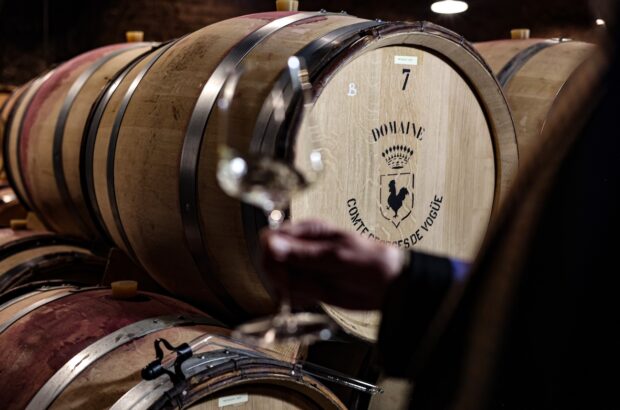Is Australia home to the world’s best natural wines? I don’t know, but it’s possible. What's certain is that natural wine-production is rarely as hilarious and good-humoured as it is in the hands of Australia's winningly lunatic fringe.
The sun was slanting through the upstairs windows above a wine bar in The Rocks, a warren of old settler streets near the Sydney Harbour Bridge — and there, amid the primly conventional bottles laid out for me to taste, were three egg-like ceramic flasks. A picture sheet, rolled onto what looked like the inside of a toilet roll and attached to the flask, showed strange scenes: hooded figures apparently laying their hands on barrels (this was, I learned later, an act of love).
The wines in had been fermented in ‘ceramic birthing spheres’, by natural yeast, of course, to appropriately concordant music, and introduced to the unsuspecting world via a singular roadshow which involved their male creators – Sam Hughes, Anton van Klopper, James Erskine and Tom Shobbrook — dressing up in hotpants and crashing wine bars, all the better to disconcert Aussie wine drinkers into the necessary revaluation of all values.
In the land, moreover, where the virtues of screwcap are prosecuted with fundamentalist zeal, these flasks were massively, insultingly, cockily cork-wodged, under a thick carapace of wax. Every sommelier’s nightmare, but perhaps that is part of the Nietzschean scheme, too.
They contained three incarnations of the 2011 ‘Natural Selection Theory’ Hunter Semillon, sourced from the fine-sited vineyards of Audrey Wilkinson. I liked them for their purity and rigour, though like all Hunter Semillon their early-picking gives them all the articulacy of shards of glass in youth. Best of all was the more gratifyingly alcoholic ‘Dandy in the Clos Birds … No Boundaries 2011’ — a Chardonnay and Verdelho blend co-fermented on Gewurztraminer and Semillon berries for five months (and bottled in a bottle). Yes, all were cloudy, but not orange; none foundered on reefs of funk. The Dandy, in fact, was sumptuous, haunting and perfumed: gingery spice over summer fruit.
I recalled the two explosively energetic 2011 Shiraz wines I had tried a few days earlier from Harkham, also in the Hunter: the 2011 Preservative Free Aziza’s Shiraz (imagine crushing a bunch of grapes in your hands and having the juice ferment between leaving your fingers and falling into your mouth) and the beautifully extracted, lingeringly deep 2011 Old Vines Shiraz: sloes and volcanoes, unsullied by oak.
On to Adelaide, where I tasted the Giallo and Piniolo made by Didi (sic). These mysterious bottles have the simplest labelling I have ever seen, almost as if their creator was trying to replicate the anonymity of the jug which would have greeted travellers passing the night in an inn somewhere in medieval Europe. The Giallo was refreshing, half-hopleaf, half-passionfruit, while the Piniolo remined me of a good Belgian Kriek, full of yeasty red fruits.
That evening I caught up with James Erskine, one of the Natural Selection Theory pranksters, and the man who (in his capacity as convenor of The Adelaide Review’s Hot 100 wine competition) had managed to instigate a class for wines with no additives of any sort other than sulphur: hurrah. Erskine’s own naturally fermented, unacidified 2011 Jauma Grenache from Wood Vineyard in Clarendon was fragrant, smooth, almost Pinot-like. At a dinner the following night, meanwhile, Glenn James-Pritchard (a former Hardys and Penfolds winemaker, now making wine under the Ducks in a Row label) banged a bottle of his extraordinary 2011 Pandora’s Amphora down on the table. Pandora’s what?
“I’d had my eye on them for some time,” he said, referring to two old amphorae which someone had left at the Kaiser Stuhl winery in Barossa. Having kidnapped them, he set about restoring them to practical use before filling them with a mixture of Vermentino, Fiano and Moscato Giallo from Bruce Chalmer’s vineyards in Heathcote. With their skins — hand-plunged, up to the armpit. The skins then stay in the amphorae for, er, seven months, with no additives of any sort. “I had to chain myself down not to add acid,” he said, but the bondage was worth it, since the gentleness of balance in this hauntingly fragrant, textured, musky white was superb (a TA of 5.5 and pH of 3.8, for the number crunchers amongst you: please can we have more Australian whites with this kind of balance).
The reason I suggest that these might be among the world’s best natural wines is this. The Australian birthright of basic winemaking literacy seems to keep even its natural wines undeviant. They are, too, made in a spirit of open-minded discovery and fun, to tweak the beards of Australia’s wine-making bourgeoisie. There’s none of the tedious self-righteousness (and grotesque scents and flavours) which accompanies some natural-wine creation in Europe.
In a land where potentially great wine is too often homogenized and neutered by adjustment, with much of its sense of terroir consequently erased, they are precious.
Written by Andrew Jefford







